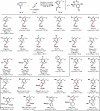Activation of remote meta-C-H bonds assisted by an end-on template
- PMID: 22739317
- PMCID: PMC3386562
- DOI: 10.1038/nature11158
Activation of remote meta-C-H bonds assisted by an end-on template
Abstract
Functionalization of unactivated carbon-hydrogen (C-H) single bonds is an efficient strategy for rapid generation of complex molecules from simpler ones. However, it is difficult to achieve selectivity when multiple inequivalent C-H bonds are present in the target molecule. The usual approach is to use σ-chelating directing groups, which lead to ortho-selectivity through the formation of a conformationally rigid six- or seven-membered cyclic pre-transition state. Despite the broad utility of this approach, proximity-driven reactivity prevents the activation of remote C-H bonds. Here we report a class of easily removable nitrile-containing templates that direct the activation of distal meta-C-H bonds (more than ten bonds away) of a tethered arene. We attribute this new mode of C-H activation to a weak 'end-on' interaction between the linear nitrile group and the metal centre. The 'end-on' coordination geometry relieves the strain of the cyclophane-like pre-transition state of the meta-C-H activation event. In addition, this template overrides the intrinsic electronic and steric biases as well as ortho-directing effects with two broadly useful classes of arene substrates (toluene derivatives and hydrocinnamic acids).
Figures



Comment in
-
Organic chemistry: Directors extend their reach.Nature. 2012 Jun 27;486(7404):478-9. doi: 10.1038/486478a. Nature. 2012. PMID: 22739310 No abstract available.
References
-
- Snieckus V. Directed ortho metalation. Tertiary amide and O-carbamate directors in synthetic strategies for polysubstituted aromatics. Chem. Rev. 1990;90:879–933.
-
- Flemming JP, Berry MB, Brown JM. Sequential ortho-lithiations; the sulfoxide group as a relay to enable meta-substitution. Org. Biomol. Chem. 2008;6:1215–1221. - PubMed
-
- Ryabov AD. Cyclopalladated complexes in organic synthesis. Synthesis. 1985:233–252.
-
- Kakiuchi F, et al. Catalytic addition of aromatic carbon–hydrogen bonds to olefins with the aid of ruthenium complexes. Bull. Chem. Soc. Jpn. 1995;68:62–83.
-
- Jun C-H, Hong J-B, Lee D-Y. Chelation-assisted hydroacylation. Synlett. 1999:1–12.
Publication types
MeSH terms
Substances
Grants and funding
LinkOut - more resources
Full Text Sources
Other Literature Sources

